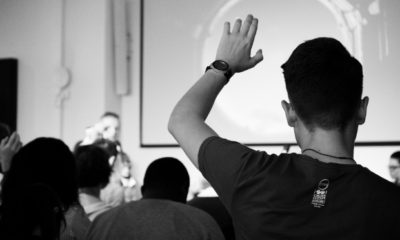Life
Your Enthusiasm Will Make A Difference

I have read Dr. Peale’s book “Enthusiasm Make The Difference.” As a matter of fact, I have read a few of his books. All of them are good reads. I love the examples and stories of his patients and clients in a world so far different than ours today. The stories are pre-internet days. Pre-everything days really. Some say it was much simpler then, than now. To a certain extent, I agree with those people. Life has sped up.
I remember my younger days with the long phone chords stretching them as far as possible to get some privacy and the big box televisions that weighed a gazillion pounds. Atari, Betamax VCR’s, eight-tracks, cassette tapes, and so many other obsolete devices we all used that no longer exist. It’s funny, those things are gone with new improved and faster technology, but the wisdom of Dr. Peale remains the same. It’s true, enthusiasm does make the difference. It was the same as in 1967 when his book was published and now in 2019. If you want people to listen to you, follow you, or learn from you, you need enthusiasm.
Enthusiasm matters
Each semester I begin all my classes doing push-ups the first day. The students come in with regular street clothes expecting to hear the usual “spiel” on the class requirements, paperwork, and the expectations for the course. Now, remember, I teach kids how to lift weights, not math or science. Following the discussion of general information, I tell them to get in a big circle in the weight room.
I teach them how to do a correct push-up and demonstrate key points to make it more safe and effective. Then, we do a lot of push-ups. I am usually met with some resistance with a few of the students. While they all elected to take the class (it is not required- but should be), they are not too keen on doing push-ups in their blue jeans or their “school clothes.” Almost 100% of the time, the students finish loving the activity. They laugh and have fun with it. Why? I make it fun for them. I am loud. I talk fast. I make jokes (they are funny to me, probably not to them).
I do the push-ups with them. I am enthusiastic about the experience! If I went into the activity with typical teacher talk, I would not get the same effect. Furthermore, if I went into it being a drill sergeant and demanded it from them, I would be met with a ton of resistance as well. I start each class and each semester with push-ups for a few reasons. I want to let them know the course will be challenging. I want to show them that you do not need a long drawn out routine for exercise to be effective. And, mostly to show them that physical training can be a fun and enjoyable experience.
“Nothing great was ever achieved without enthusiasm.” – Ralph Waldo Emerson
When I coach wrestling, I might not smile as much, at least in the beginning, but I make it a priority to be enthusiastic each day. I talk to my team a lot about the proper mindset they need to have each day to have a good practice and to get the most out of the workout. I tell them that it will be tough and needs to be tough because from that we get better, and we will shorten the learning curve with other teams that have more experience.
I participate in most conditioning workouts with them. I want to share the experience with them. By doing that, I build trust and rapport. Ultimately though, what matters most is that each day I (and my other coaches) are enthusiastic in what we do.
Enthusiasm is the “secret sauce” in nearly every life activity. Whether it is mowing the lawn or working out, having energy and spirit make any challenging experience better. Enthusiasm also brings out the best in others!
How to develop enthusiasm
Let’s be clear before I discuss ways to develop enthusiasm with your team or daily life, it isn’t Pollyanna double-speak and painting a rosy picture to your students, organization, or employment staff. Enthusiasm is bringing passion and love into an experience and doing it with energy and vitality. It is selling your people to buy into your program, and it is showing up prepared and ready to attack what’s ahead of you. It is not getting through it and surviving.
How can we develop an enthusiastic attitude? It first begins in your own mind! Everything we do starts in our minds. To be passionate, you need to plant the seeds of enthusiasm into your thinking. You need to tell yourself that it’s going to be a great experience and your day is going to be filled with opportunities!
You tell yourself you are “lucky” to have the chance to do whatever you do. What if you do not feel that way? Well, you lie to yourself. You keep telling yourself that it is going to be good. You catch the negative thinking right away and quickly change it to something that will benefit and motivate you.
In what ways can we demonstrate enthusiasm with others? The biggest thing that will show your enthusiasm is your body language, tone of your voice, and facial expressions. In other words, your physiology. If you want people to be enthusiastic, you demonstrate it first. You talk louder. You move faster. Equally important, you smile and have some fun in what you are doing.
And if you don’t feel that way when you start, fake it, do it anyway, and I guarantee you will quickly morph into the person you are trying to be. You will get excited and feel full of energy. You “trick” yourself into being enthusiastic and low and behold after a couple of minutes, you are!
“Enthusiasm releases the drive to carry you over obstacles and adds significance to all you do.” – Norman Vincent Peale
So remember, enthusiasm starts in your own thinking. If you think lazy and uninspiring thoughts, the result will be that you are lazy and uninspired in your daily living and communication with people. You need to change your thinking deliberately. At first, it will need to be repetitive and constant. Eventually, it only takes a quick reframe of your negative thought to turn it into a positive one. But like anything else in life that’s worth it, it takes time and effort.
You also have to move your body like a person who has enthusiasm. “Fake it till you make it.” If you move your body intending to be enthusiastic, your mind will follow.
Did You Know
How Skilled Migrants Are Building Successful Careers After Moving Countries
Behind every successful skilled migrant career is a mix of resilience, strategy, and navigating systems built for locals.

Moving to a new country for work is exciting, but it can also be unnerving. Skilled migrants leave behind familiar systems, networks, and support to pursue better job opportunities and a better future for their families. (more…)
Life
10 Research-Backed Steps to Create Real Change This New Year
This New Year could finally be the one where you break old patterns and create real, lasting change.

Every New Year, we make plans and set goals, but often repeat old patterns. (more…)
Life
9 Harsh Truths Every Young Man Must Face to Succeed in the Modern World
Before chasing success, every young man needs to face these 9 brutal realities shaping masculinity in the modern world.

Many young men today quietly battle depression, loneliness, and a sense of confusion about who they’re meant to be.
Some blame the lack of deep friendships or romantic relationships. Others feel lost in a digital world that often labels traditional masculinity as “toxic.”
But the truth is this: becoming a man in the modern age takes more than just surviving. It takes resilience, direction, and a willingness to grow even when no one’s watching.
Success doesn’t arrive by accident or luck. It’s built on discipline, sacrifice, and consistency.
Here are 9 harsh truths every young man should know if he wants to thrive, not just survive, in the digital age.
1. Never Use Your Illness as an Excuse
As Dr. Jordan B. Peterson often says, successful people don’t complain; they act.
Your illness, hardship, or struggle shouldn’t define your limits; it should define your motivation. Rest when you must, but always get back up and keep building your dreams. Motivation doesn’t appear magically. It comes after you take action.
Here are five key lessons I’ve learned from Dr. Peterson:
-
Learn to write clearly; clarity of thought makes you dangerous.
-
Read quality literature in your free time.
-
Nurture a strong relationship with your family.
-
Share your ideas publicly; your voice matters.
-
Become a “monster”, powerful, but disciplined enough to control it.
The best leaders and thinkers are grounded. They welcome criticism, adapt quickly, and keep moving forward no matter what.
2. You Can’t Please Everyone And That’s Okay
You don’t need a crowd of people to feel fulfilled. You need a few friends who genuinely accept you for who you are.
If your circle doesn’t bring out your best, it’s okay to walk away. Solitude can be a powerful teacher. It gives you space to understand what you truly want from life. Remember, successful men aren’t people-pleasers; they’re purpose-driven.
3. You Can Control the Process, Not the Outcome
Especially in creative work, writing, business, or content creation, you control effort, not results.
You might publish two articles a day, but you can’t dictate which one will go viral. Focus on mastery, not metrics. Many great writers toiled for years in obscurity before anyone noticed them. Rejection, criticism, and indifference are all part of the path.
The best creators focus on storytelling, not applause.
4. Rejection Is Never Personal
Rejection doesn’t mean you’re unworthy. It simply means your offer, idea, or timing didn’t align.
Every successful person has faced rejection repeatedly. What separates them is persistence and perspective. They see rejection as feedback, not failure. The faster you learn that truth, the faster you’ll grow.
5. Women Value Comfort and Security
Understanding women requires maturity and empathy.
Through books, lectures, and personal growth, I’ve learned that most women desire a man who is grounded, intelligent, confident, emotionally stable, and consistent. Some want humor, others intellect, but nearly all want to feel safe and supported.
Instead of chasing attention, work on self-improvement. Build competence and confidence, and the rest will follow naturally.
6. There’s No Such Thing as Failure, Only Lessons
A powerful lesson from Neuro-Linguistic Programming: failure only exists when you stop trying.
Every mistake brings data. Every setback builds wisdom. The most successful men aren’t fearless. They’ve simply learned to act despite fear.
Be proud of your scars. They’re proof you were brave enough to try.
7. Public Speaking Is an Art Form
Public speaking is one of the most valuable and underrated skills a man can master.
It’s not about perfection; it’s about connection. The best speakers tell stories, inspire confidence, and make people feel seen. They research deeply, speak honestly, and practice relentlessly.
If you can speak well, you can lead, sell, teach, and inspire. Start small, practice at work, in class, or even in front of a mirror, and watch your confidence skyrocket.
8. Teaching Is Leadership in Disguise
Great teachers are not just knowledgeable. They’re brave, compassionate, and disciplined.
Teaching forces you to articulate what you know, and in doing so, you master it at a deeper level. Whether you’re mentoring a peer, leading a team, or sharing insights online, teaching refines your purpose.
Lifelong learners become lifelong leaders.
9. Study Human Nature to Achieve Your Dreams
One of the toughest lessons to accept: most people are self-interested.
That’s not cynicism, it’s human nature. Understanding this helps you navigate relationships, business, and communication more effectively.
Everyone has a darker side, but successful people learn to channel theirs productively into discipline, creativity, and drive.
Psychology isn’t just theory; it’s a toolkit. Learn how people think, act, and decide, and you’ll know how to lead them, influence them, and even understand yourself better.
Final Thoughts
The digital age offers endless opportunities, but only to those who are willing to take responsibility, confront discomfort, and keep improving.
Becoming a man today means embracing the hard truths most avoid.
Because at the end of the day, success isn’t about luck. It’s about who you become when life tests you the most.
Change Your Mindset
The Four Types of Happiness: Which One Are You Living In?
Most people chase success only to find emptiness, this model reveals why true happiness lies somewhere else.

In a world driven by rapid technological growth and constant competition, many people unknowingly trade joy for achievement. (more…)
-

 Shift Your Mindset4 weeks ago
Shift Your Mindset4 weeks ago11 E’s That Define Every Great Leader And Why Most People Miss Them
-

 Did You Know4 weeks ago
Did You Know4 weeks agoThe Success Patterns You Inherited (And Didn’t Notice)
-

 Entrepreneurs3 weeks ago
Entrepreneurs3 weeks agoThe Essential Skills Every Entrepreneur Needs In 2026
-

 Business4 weeks ago
Business4 weeks agoThe Hidden Money Pit in Your Operations (and How to Use It)
-

 Change Your Mindset2 weeks ago
Change Your Mindset2 weeks agoHow to Turn Your Mind Into Your Greatest Asset (Instead of Your Enemy)
-

 Change Your Mindset2 weeks ago
Change Your Mindset2 weeks agoThe Silent Skill That Makes People Respect You Instantly
-

 Life2 weeks ago
Life2 weeks ago10 Research-Backed Steps to Create Real Change This New Year
-

 Tech1 week ago
Tech1 week agoWhat’s in a Name? How to Get Your Domain Right

























